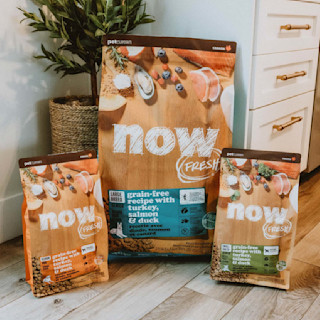December 2, 2024
What to Look for in Dog Food Ingredients

Knowing what to look for in dog food ingredients can feel like a daunting task, with everything from premium ingredients to specific health benefits to consider. So, we’ve broken it down to help guide you through the important elements to look for in dog food: what ingredients are beneficial, and what ingredients to avoid in dog food.
It All Starts with Ingredients
The quality of ingredients is key, as these provide the important and essential nutrients which our pets need to stay healthy and thrive.
Unfortunately, just reading the ingredient panel may not tell you everything you want to know about ingredient quality.
So, what do you do when you want to know more than just what’s on the label, such as where the ingredient comes from or how it’s processed? The best way to get more information about what’s in your pet’s bowl is to talk to the people behind the food; reach out to your pet food brand and ask specific questions. A trustworthy brand will be transparent and give you detailed information about their ingredients, manufacturing process, and quality assurance standards to help you make an informed decision.
Understanding "Complete and Balanced" Nutrition for Dogs
We hear that term, "complete and balanced", a lot in the pet food industry, but what does it mean? Essentially, it means that a food contains the proper proportions of every single nutrient dogs need to sustain long term health, when fed in the proper amounts according to their size, age, and activity level. For example, fast-growing puppies require more protein and more controlled minerals compared to adult dogs, in order to support their growth spurts and muscle development.
And as our dogs get older and a little slower, they can benefit from a senior diet which typically contains more moderate protein and fat than an adult diet, to help keep them at a healthy weight as their metabolisms slow.
Key Ingredient Categories to Look For
Ingredients are the vehicles for providing by four main categories of nutrients:
1. Protein
Protein ingredients, like meat and fish, are often one of the first ingredients pet parents look for when choosing a recipe for their dog. But what is protein for, and how much do dogs really need?
Proteins are made up of amino acids, the building blocks of muscle and other tissue; their job is to develop and repair tissue, helping keep muscles strong. Amino acids from protein are essential, and the body needs a certain amount of protein to do this job.
However, more is not necessarily better. The body is not able to store excess protein, so any amount more than what that particular body can use becomes body fat or is passed out of the body as nitrogen (urea) in the urine, which can be tough on aging kidneys and the environment. In general, most typical, healthy adult companion dogs do best on a diet with 22-26% protein.
As with all nutrients, the amount of protein your dog eats is important, but more does not mean better.
Equally important to quantity is the quality of protein. Fresh de-boned meat, meat meals, and meat by-products are all types of ingredients you may find listed on your dog’s food, which may have you wondering which you should choose.
Protein quality can be determined by the amount and levels of amino acids it contains, how this compares to the dog’s needs, plus how digestible it is. In fact, dogs who consume higher quality protein need less total protein to meet their amino acid requirements^1. This is because high quality proteins have complete amino acid profiles and are highly digestible and readily available to the body. Good examples of high-quality proteins include minimally processed fresh meats and eggs. Keeping processing to a minimum can also help to preserve nutrients, plus enhance flavour.

Our Recommendation
Premium Dog Food Made with Fresh Meats & Fish
Our dog food recipes use minimally processed fresh de-boned meats and fish, like turkey, salmon and duck, whole eggs, with no by-product meals.
View all dog food2. Fats
Fats, or more specifically, certain fatty acids are essential to the body too, as they are key in development and metabolism. More generally, the body uses fats as an energy source, but they also lend a hand in boosting the flavour of your dog’s food. There are a variety of types of fatty acids, but 2 groups specifically are considered essential. These groups are:
Omega-3 Fatty Acids: These are known to be mostly anti-inflammatory. EPA and DHA are two essential fatty acids in this category. Salmon is an excellent source of omega 3 fatty acids, including EPA and DHA.
Omega-6 Fatty Acids: Omega-6 plays a significant role in your dog's skin health by maintaining the skin's outermost water barrier. Linoleic acid (LA) is an essential fatty acid in this category. Canola oil is a great source of LA.
Though both groups are essential fatty acids, the key is to include the proper balance of omega-3 and omega-6's. Too much omega 6s or not enough omega 3s in a food can contribute to low grade inflammation that is associated with certain diseases.
A diet containing 11-15% total fat for dogs is generally appropriate for most adults. Puppies have an additional requirement for some omega-3 fatty acids, DHA and EPA, which are important for brain development.
3. Carbohydrates
Carbohydrates sometimes get a bad rap but they play an important role in a dog’s diet. First, carbs provide an easily accessible source of energy to the body, to give your dog that pep in their step. Secondly, carbs include fibre; dogs use fibre to support a healthy digestive system and well-formed stool. Finally, carbs play an essential role in the texture of both dry and wet food.
If your dog prefers a certain kibble crunch or the softness of a pâté, you have carbs to thank for that. High quality sources of carbohydrates used in pet foods include grain options such as oats and rice, or grain free options such as peas, potatoes, or lentils.

4. Specialized Ingredients for Health Benefits & Nutrient Boosts
There are certain ingredients that excel in nutrient quantity or provide specific benefits which you can look for to help guide your decisions. Some fruits and veggies, like cranberries and pomegranate, are particularly dense in vitamins and antioxidants are often referred to as “superfoods”.
Ingredients That Support Digestion
Enterococcus Faecium & Lactobacillus Acidophilus: Two probiotics, which are good microorganisms that live in the digestive tract and support healthy digestion.
Minimally processed fresh de-boned meat ingredients, like turkey, salmon, and duck.
Pumpkin: An ingredient rich in dietary fibre.
Ingredients That Support Immune System Health
Fruits & veggies, like blueberries, cranberries and broccoli that are rich in vitamin C & K.
Ingredients That Support Heart Health & Weight Management
L-carnitine: An amino acid-like compound that aids in healthy fat metabolism and supports heart health, plus promotes the burning of free fatty acids, instead of depositing as fat tissue.
Ingredients That Support Joint Health
New Zealand green mussels: A natural source of chondroitin, and the anti-inflammatory omega-3 fatty acid ETA.
Glucosamine hydrochloride: An aid for joint support. Both glucosamine and chondroitin are found in joint cartilage and work synergistically to support joint health.
Chondroitin sulfate: An important component of cartilage that supports joint health, especially in combination with glucosamine hydrochloride.
Ingredients that Support Clean Teeth & Fresh Breath
Sodium tripolyphosphate: A mineral blend which binds calcium to support dental health.
Parsley & peppermint: Natural breath fresheners that help maintain your dog’s fresh breath.
What Ingredients to Avoid in Dog Food
Artificial Additives
Some no-no’s when it comes to natural, premium quality nutrition are artificial colours and preservatives. On an ingredient panel, artificial colours typically are listed as a colour followed by a number, like “blue 1”. or “yellow 5”. The most common artificial preservatives used in pet foods are ethoxyquin (EMQ) and butylated hydroxytoluene (BHT).
Unspecified Meat Sources
Many pet parents also choose to steer clear of unnamed generic meat meals, by-product meals and meat and bone meals. These are considered the lower quality animal protein ingredients as they’re made up of multiple, unknown animal sources with unwanted ingredients included like excess bone, intestine lining, heads, or feet. Typically, you won’t find this in more expensive dog food.
Conclusion
Choosing the right dog food is essential for your pet's health and well-being. By understanding what to look for in dog food ingredients, you can make informed decisions that support your dog's nutritional needs. High-quality proteins, healthy carbohydrates, beneficial fats, fibre, and a balanced mix of vitamins and minerals are key components of a nutritious diet.
Avoiding artificial additives and unspecified meat sources ensures that your dog receives the best possible nutrition. Remember, the quality of ingredients is paramount, and seeking transparency from pet food brands can help you make the best choices for your furry friend. With the right knowledge, you can provide your dog with a diet that promotes long-term health and happiness.
Oberbauer, A.M., Larsen, J.A. 2021. Amino Acids in Dog Nutrition and Health. In: Wu, G. (eds) Amino Acids in Nutrition and Health. Advances in Experimental Medicine and Biology, vol 1285. Springer, Cham. https://doi.org/10.1007/978-3-030-54462-1_10.
Authors




